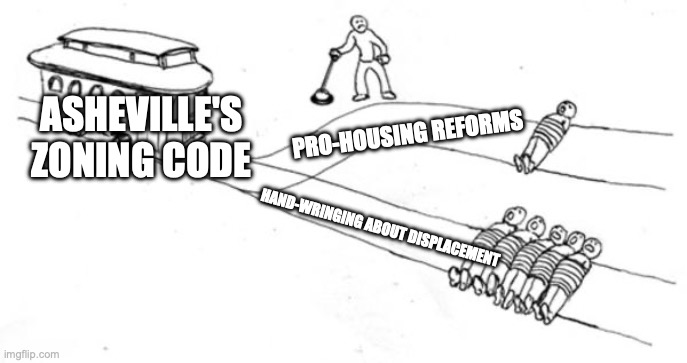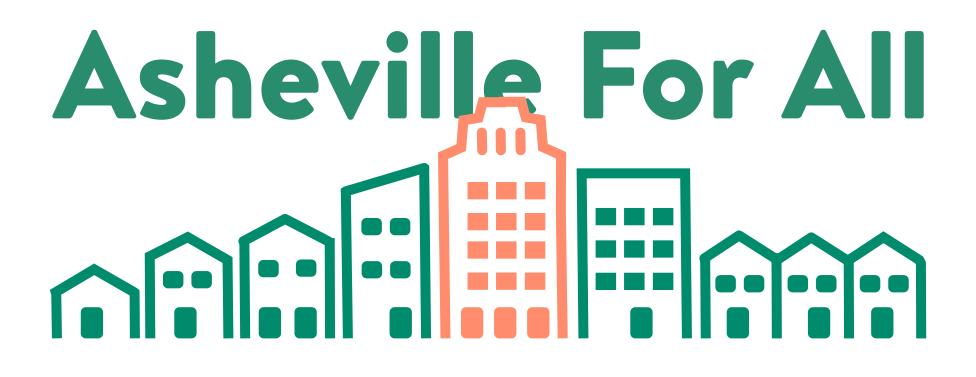Building Asheville’s “Zoning Buffer”
November 7, 2023
This member commentary post does not necessarily reflect the views of Asheville For All or its members.
Last month, Asheville’s city planning department briefed the Neighborhood Advisory Committee on the Flag Lot Amendment that the City Council will be voting on in January.
I wrote about that amendment here, and you can find the city staff briefing here.
There’s something interesting about the language in the memo. On one hand, staff rightly note that Asheville has a severe housing shortage, and that “we must find ways to provide additional housing.”
On the other hand, there’s some handwringing about the potential for this flag lot proposal—which would allow homeowners to build additional homes on unused land as a means to create more infill density—to “accelerate displacement.” Does this mean that we are forever facing a Catch-22? We need more homes, but we can never increase the city’s capacity for them?
We know that displacement is happening right now in Asheville. It’s happening because rents are rising fast, and that’s because in a landscape of severe shortage, landlords can effectively have their pick of tenants, and can charge what they want. It’s happening because tenants are being pitted against one another, forced to “bid up” the price of housing. (And the same is true for homebuyers, especially first-timers.) And it’s happening because when someone has to move—say their family outgrows their present accommodations—there is nowhere else to go. There are so few vacancies.
Personally, I believe that the stress we place on the potential for pro-housing changes to cause displacement is short-sighted and driven by a status quo bias. After all, the status quo is seeing people being driven out of their homes right now, possibly every day.
(It’s a bit like the famous “trolley problem.” Sometimes it feels like we’d rather do nothing, even if it means the housing crisis will only get worse.)

But let’s take the dominant narrative around displacement seriously for a moment—the dominant narrative, I think, being that which sees “development” as a threat to housing stability. It’s an absolute fallacy that more housing, even fancy new housing, causes rents and/or home prices to rise. But what about the concern that new, pro-housing land use reforms to our zoning code—which we might call “upzoning” for short—will lead to speculation or market churn in the short term that will put people out of their homes?
The Zoning Buffer
Shane Phillips, a UCLA professor that specializes in housing policy offers a good answer to this question in a concept that he calls the “zoning buffer.” What Phillips found is that upzoning works best to generate housing supply and simultaneously mitigate speculative pressure when it is broad, and shallow relative to its breadth.
What does that mean? Well, if City Council decided tomorrow that the Erskine neighborhood was suddenly to get residential buildings up to twenty stories, no “open space” requirements, and all parking mandates abolished, we might see an increase in housing stock—and maybe even a dramatic amount, over time—and that would be a good thing for our housing shortage. It is an incontrovertible truth that when we allow more housing to be built in areas close to jobs and amenities—places that are walkable, and places where people want to live—vacancies go up, rents go down, and this is true for a broad swath of incomes and family types. And it’s a positive effect that touches neighboring communities and those across town.
But we can also imagine that this dramatic upzoning of Erskine might cause some considerable disruption to some people’s lives. Tenants in that neighborhood may get kicked out of their homes as landlords seek to redevelop their property or sell because the land would now have potential for greater income. And if that land is suddenly valued higher, owner-occupiers may also find themselves in a crunch if they can’t afford to pay property taxes anymore. So even if there’s certainly a net gain for working people in Asheville who would see an easing in upward pressure on rents and home prices, we don’t want people falling through the cracks, if we can help it.
But with broad upzoning—let’s say a moderate increase in allowed residential density within a quarter mile of all bus stops everywhere in the city, along with the permitting by right of duplexes, triplexes, and quadplexes anywhere served by a sewer line—the potential gains from current landowners is diffused across a bigger geography. Or as Phillips puts it, “land with redevelopment potential is no longer scarce.” This isn’t to say that we don’t need tall buildings or much denser neighborhoods in Asheville. But it’s to say that the more we allow our population capacity to keep up with our housing demand through broad and incremental changes, the less shocks tenants might experience alongside the city’s growth. Shane Phillips argues that this kind of broad construction of a “zoning buffer” is what allows us to keep offering opportunities for diverse populations in neighborhoods where people want to live while mitigating deleterious side effects for members of such populations.
What Does Broad and Relatively Shallow Pro-Housing Reform Look Like?
What’s most perplexing to me is that the flag lot amendment appears tailor-made to promote “gentle density” without requiring the razing of lots, or the redevelopment of entire neighborhoods. It is broad in that it applies not to one single neighborhood but rather to any lot in the city with enough depth to support multiple single-family homes. And it’s a relatively shallow pro-housing reform in that all limits to density and size that are presently in place in each neighborhood still apply.
So here’s the good news. Despite the confusing language of the city’s planning staff’s briefing to the Neighborhood Advisory Council, I think that the staff already understands all of this stuff. The staff, to their credit, has issued its support of the flag lot amendment. (I think that in their messaging to the Neighborhood Advisory Council, they just wanted, or needed, to cover all the bases.)
And beyond that measure, it appears to be wholly supportive and enthusiastic about the project to transform Asheville’s zoning code to permit, encourage, and incentivize “middle type” housing.
I want to close with just a quick note on that project. If you’re not up to speed on what “missing middle” or “middle type” means, check out Asheville For All’s info page here.
There will surely be homeowners in Asheville that will fight back against “missing middle” reforms with the argument that this kind of change is too dramatic and too broad. As I’ve suggested here, breadth is going to be key for a new zoning code to pass; we need every neighborhood to feel like every other neighborhood is chipping in. But I’ve also suggested that depth is important too. The city should be ambitious when it rewrites the zoning code.
I would argue, given the rubric that Phillips suggests, that it’s the potential breadth of missing middle reform that allows for an ambitious approach to rewriting our zoning code. That’s why it’s important to say “relatively shallow.” We should not misunderstand Phillips’s concept in a way that handicaps the opportunity we’ll have next year to pass real substantive pro-housing reform through City Council.
This member commentary post does not necessarily reflect the views of Asheville For All or its members.
